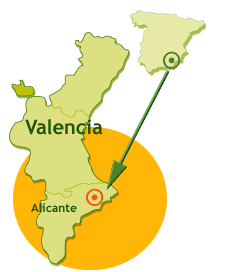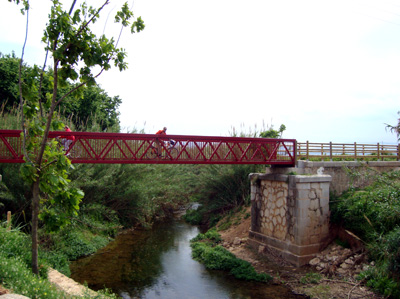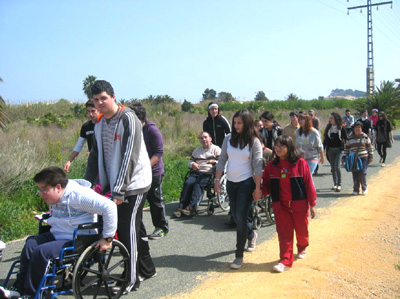|
 Back to index Back to index
|
| Itineraries > Dénia Greenway |
|
|

|
A journey between orange trees along the Alicante coast
The Dénia Greenway follows the route of the old narrow gauge Carcaixent-Dénia line, passing through a sea of orange trees as it runs parallel to the coast north of the historic city of Dénia, which sits at the foot of Mount Montgó. The old railway line offers a pleasant way to go to the beach at Las Marinas, to visit neighbouring villages, or to travel onwards to the Marjal natural park.
|
| WRITE YOUR REVIEW
|
| Technical Data
|
|
 CONDITIONED GREENWAY CONDITIONED GREENWAY
|
A pleasant journey through an agrarian landscape of orange trees
LOCATION
Between Dénia and the municipal border of Dénia-Els Poblets
ALICANTE
Length: 6 km
Type of surface:
Dual surface. Liquid asphalt covered with gravel and compacted gravel
Natural setting:
An agrarian landscape with a predominance of orange trees. Riparian vegetation alongside irregular water courses.
|
|
 |
Views of Mount Montgó and the Sierra Segaria range of hills. Rural houses and stately homes surrounded by pines, araucarias, carobs, palm trees, etc. Pine woods nearby
Cultural heritage:
Historic town of Dénia
Infrastructure:
Greenway. Former Dénia-Carcaixent railway station in Dénia, Apeadero* de El Palmar and a level-crossing keeper’s cottage. Five rest areas with litter bins, benches, tables, information panels and maps. Kilometre stones, safety rails and reforested shoulders. Three wooden footbridges and one metal bridge over the River Alberca. One road overpass. Disused train station at El Verger/Vergel
How to get there:
By rail: Station in Dénia: Ferrocarriles de la Generalitat Valenciana. Tranvía Metropolitano (tramway/light railway) Alicante-Dénia. www.fgv.es
By boat: Port of Dénia: Balearia. Baleares-Dénia ferry
By: Alsa, Carrió, Alsa-Enatcar, Autobuses Dénia and Esteve bus companies
Connections:
Dénia, 86 km from Alicante and 103 km from Valencia
*Note: The term ‘Apeadero’ is used to refer to a small station, typically with few facilities and often unstaffed. In Britain such a station used to be known as a ‘Halt’ although the term (but not the concept) has fallen into disuse, for reasons of image
|
|
|
|
| Description
|
|
Km. 0 / Km. 3 / Km. 5,8
|
 The Dénia Greenway starts to the north of the town, with a connection from the town centre by means of a cycle path which begins at the foot of the castle walls. It heads off from the Ronda de las Murallas street, before joining the Avda de Alcoy avenue and the Camino de Gandia (CV-723) road. At a sign which says: “Vía verde Dénia-El Verger” we leave the main road to take a street which runs alongside a nursery. 160 m further on we arrive at the start of the Greenway. The Dénia Greenway starts to the north of the town, with a connection from the town centre by means of a cycle path which begins at the foot of the castle walls. It heads off from the Ronda de las Murallas street, before joining the Avda de Alcoy avenue and the Camino de Gandia (CV-723) road. At a sign which says: “Vía verde Dénia-El Verger” we leave the main road to take a street which runs alongside a nursery. 160 m further on we arrive at the start of the Greenway.
Kilometre zero of the Greenway is marked on the right hand side of the street. There users will find a rest area with information panels showing the route and suggestions for other walking or cycling routes around Dénia and nearby villages. Two disabled persons’ parking places cater for people with disabilities wishing to enjoy the countryside.
Km. 0
 The first part of the Dénia Greenway runs between orange, carob and almond trees before two wooden bridges takes it over a culvert and the Barranco de la Morxama stream. Next a pretty palm-lined track crosses the trail on its way to a country house. The first part of the Dénia Greenway runs between orange, carob and almond trees before two wooden bridges takes it over a culvert and the Barranco de la Morxama stream. Next a pretty palm-lined track crosses the trail on its way to a country house.
At the second rest area (km 1.1) we find an information panel describing the history of the old railway line that used to run along this route, with interesting photos of the different types of locomotives. The route then enters a long straight section which cuts through the orange trees on either side of the trail. Above the crowns of the fruit trees tower the lofty pines growing in the country estates that are dotted along the left side of the trail.
The Greenway is punctuated by a number of level crossings of lightly used tarmacked rural roads which, if we turned right, would take us down to the beach. At one of these crossings there is an old level-crossing keeper’s cottage (km 1.7) on which it still possible to make out a faded plaque indicating the old 61.86 kilometre point.
Another wooden bridge takes us over the Barranco de l‘Alter stream (km 2.3). Here we can look out over the agrarian landscape surrounding the Greenway; to our left we see the tall chimney of a drying house where grapes used to be dried to make raisins, while ahead of us the trail curves gently to the left. Now behind us we can see Dénia Castle and the impressive silhouette of Mount Montgó (751 m above sea level) with its natural park.
Km. 3
 After passing under the only road bridge on the route, we arrive at the rest area and station (apeadero) of El Palmar (km 3). The station, faithfully restored, provides a magnificent shelter from both the sun and the rain at the midway point of our route. An information panel tells us how hard it was to drive the old steam locomotives along this line, with a first-hand account from a train driver. It also describes the human side of the railway and its passengers in the 40s to 60s of the 20th century. After passing under the only road bridge on the route, we arrive at the rest area and station (apeadero) of El Palmar (km 3). The station, faithfully restored, provides a magnificent shelter from both the sun and the rain at the midway point of our route. An information panel tells us how hard it was to drive the old steam locomotives along this line, with a first-hand account from a train driver. It also describes the human side of the railway and its passengers in the 40s to 60s of the 20th century.
After a fourth rest area (km 3.7) the Greenway once again ploughs a straight path between orange trees, with a view of the Sierra Segaria hills dominating the horizon.
 
The metal bridge over the River Alberca (km 4.4), built upon the original stone abutments, spans one of the most attractive settings of the entire route. A profusion of reeds line and invade the irregular water course of the River Alberca, which can sometimes dry up completely in the summer months. On the far bank the Greenway shares a section of its route with vehicles. An information panel standing next to the bridge describes the flora and fauna of the landscape that we are walking or cycling through.

Km. 5,8
The Dénia Greenway comes to an end at the rest area at km 5.8.

Connection between the Dénia Greenway and the La Safor Greenway (Oliva – Gandía)
If we continue along the old rail bed, now a tarmacked path, after 1 km we reach El Verger where, once across the bridge over the River Girona, we find the disused railway station.
Do we feel like continuing?
A pleasant stroll or bike ride from El Verger through the La Marjal de Pego-Oliva Natural Park takes us to Oliva where we can link up to the other recovered section of the old Dénia-Carcaixent railway line: the 7 km long La Safor Greenway. The route is totally flat along a cycle path and a number of quiet country lanes running through La Marjal.
From the former railway station we pass through the town centre of El Verger along the Avenida de la Vía, which runs into Calle Creu street before arriving at the Avenida de Valencia roundabout.
At the roundabout we leave the old railway behind us and take the bike lane running parallel to the road to Pego. After crossing a bridge spanning the motorway and then passing a petrol station, we arrive at along straight at the end of which we can see the town of Pego.
Just when the straight starts there is a right turn sign. There we leave the bike lane and cross the road, where we travel along a dirt road, past a house, and then enter the Pego-Oliva Natural Park. At first we need to travel parallel to a canal for 400 m before crossing a bridge that takes us to the far side. This pleasant route through the natural park comes to an end when we cross over a bridge spanning the sluice gates of the River Bullent. 400 m later we reach Font Salada, a natural swimming pool fed by hot springs with recognized therapeutic properties. The route continues along rural lanes to the town of Oliva, which we cross from south to north. Halfway along we link up with a cycle path that takes us straight to the starting point of the La Safor Greenway to Gandía.
Further information: Safor Greenway.
If you wish to know about other hiking and cycling routes around Dénia: click here and download the map (PDF).
View map of connection between the two greenways. Click here.
|
|
|
|
|
|
|
|
| Railway History
|
 The Dénia Greenway makes use of the southernmost end of the disused Carcaixent - Dénia railway line, the oldest narrow gauge line on the Spanish Peninsula, which ran for 90 years before it was finally closed down for good. The Dénia Greenway makes use of the southernmost end of the disused Carcaixent - Dénia railway line, the oldest narrow gauge line on the Spanish Peninsula, which ran for 90 years before it was finally closed down for good.
The first stretch, from Carcaixent to Gandía, dates back to 1864 and started its life as an animal-drawn tramway some 35 km long. Later, in 1884, it was extended to Dénia, now as a conventional steam-powered railway.
The train served a markedly agricultural purpose; its main job was to haul citrus fruits from the orchards in Valencia to the Port of Dénia.
Its quiet existence was rudely interrupted in 1969 when the Carcaixent-Gandía was closed down. However, a few years later a small part of its length (between Tavernes and Gandía) would be taken over by a modern suburban train from Valencia via Silla-Cullera. The first broad gauge trains reached Gandía in 1972.
The second Dénia-Gandía stretch closed down in 1974 with the hope that its route would be used to extend the suburban (Cercanías) line to Dénia. But the project never came to fruition.
 After 36 years of abandonment, during which time there were a number of attempts to reopen the railway, in 2010 the route was once again put to use, thanks to an initiative by Dénia Town Council and the development work performed within the framework of the Ministry of Environment’s Nature Trails Programme. Now hundreds of walkers and cyclists, from every walk of life, fit or disabled, travel the 5.8 km route through Dénia every day. After 36 years of abandonment, during which time there were a number of attempts to reopen the railway, in 2010 the route was once again put to use, thanks to an initiative by Dénia Town Council and the development work performed within the framework of the Ministry of Environment’s Nature Trails Programme. Now hundreds of walkers and cyclists, from every walk of life, fit or disabled, travel the 5.8 km route through Dénia every day.
The old Dénia station is the most important building along the Greenway. It is home to the Toy Museum, set up as a tribute to the town’s toy-making tradition; in the 20th century the town boasted many toy factories. The station also features an exhibition hall.
|
|
|
| Interesting Data
|
|
|
|
|
|
|
|
|
|
|
|
|
1. Popular Festivals |
|
|

|
|
|
|
|
2. Accomodations |
|
|
|
|
|
|
3. Eco-tourism |
|
|
|
|
|
|
4. Bike Rental |
|
|
|
|
|
|
5. Town Council |
|
|
|
|
|
|
6. Emergencies |
|
|
|
|
|
|
7. Transports |
|
|
|
|
|
|
|
|
|
|
|
|
|
|
Popular Festivals
|
 return return |
|
|
|
|
|
|
|
Música al Castell – a festival of traditional and popular music. Music from various regions in Spain and around the world. Summer.
Cine Vora Mar. Beach cinema. Summer.
International Music Week. August.
Muestra de Danza Folklórica (Folk Dancing Exhibition). First week in September.
Cabalgata de Reyes Magos (Epiphany parade). January 5.
Pilgrimage / procession to the Santa Paula Hermitage. January 26.
Carnival. Saturday before Lent.
Medio Año de Moros y Cristianos. Last weekend in February.
Fallas. March 16, 17, 18 and 19.
Virgen de los Desamparados. Second Sunday in May. |
|
Fiestas de Jesús Pobre. May 17 to 25.
Fiestas en la calle de la Santísima Trinidad. Mid-June.
San Juan Bonfires. June 21 to 24.
Fiestas en la Ermita de San Juan. June 21 to 24.
Fiestas en la calle de San Pedro. June 28 to 30.
Festa Major. Fiestas patronales en honor a la Santísima Sangre and “Bous a la Mar”. July 5 to 13.
Moros y Cristianos. Fiestas en honor a San Roque. August 13 to 16.
Fiestas de La Xara. Late August or early September.
Pilgrimage / procession to the Santa Lucía Hermitage. December 13. |
|
|
|
|
|
|
|
|
|
|
|
|
Accomodations
|
 return return |
|
|
|
|
|
|
|
|
|
|
|
|
|
|
|
|
|
|
|
|
|
|
Eco-tourism
|
 return return |
|
|
|
|
|
|
|
Archaeological area and museums of the Dénia Town Council. Guided tours. Tel. 966 420 260.
Department of the Environment of Dénia Town Council
Excursions to discover the landscape diversity of the area.
e-mail: mediambient@ayto-denia.es
Mundo Marino. Boat trips round Dénia, Jávea, Calpe, Altea, Alicante and Valencia.
|
|
|
|
|
|
|
|
|
|
|
|
|
Bike Rental
|
 return return |
|
|
|
|
|
|
|
|
|
|
|
|
|
|
|
|
|
|
|
|
Town Council
|
 return return |
|
|
|
|
|
|
|
|
|
|
|
|
|
|
|
|
|
|
|
|
|
|
Emergencies
|
 return return |
|
|
|
|
|
|
|
Emergencies. Telf. 112
Local Police. Telf. 092; www.denia,es
Medical Emergencies. Telf. 965 788 212; www.suma.es
Help (in Foreign Languages).Telf. 966 429 000. Ext-4105
|
|
|
|
|
|
|
|
|
|
|
|
|
Transports
|
 return return |
|
|
|
|
|
|
|
Railways
Ferrocarriles de la Generalitat Valenciana. Tranvía Metropolitano (Tram) Alicante-Dénia.
Tel. 900 720 472; www.fgvalicante.com
FGV Alicante: 96 526 27 31; www.fgv.es
FGV Dénia: 96 578 04 45; www.fgv.es
Consult the conditions under which bikes can be carried on trains
Ferry
Balearia. Ferry Baleares-Dénia
Tel. 902 160 180; www.balearia.com
Coaches & Buses
Alsa-Enatcar
Destinations: Madrid, Barcelona, Murcia, Granada, Almería, Málaga, Algeciras, Sevilla, Córdoba, Albacete, Tarragona, Valladolid, León, Oviedo and Gijón. Tel. 902 422 242; www.alsa.es
Alsa-Ubesa
Destinations: Valencia and Alicante; Tel. 902 422 242; www.alsa.es
Carrió
Destinations: Jávea, Ondara, Vergel, Beniarbeig, Sanet, Benimeli, Ráfol, Sagra, Tormos, Orba, Parcent, Alcalalí and Jálon. Tel. 626 979 740; 96 558 10 36; www.autocarescarrio.es
Esteve
Destinations: Vall de Laguart, Pedreguer y Benidoleig. Tel. 639 404 439; 96 558 37 46
victoresteve@yahoo.es
Dénia
Urban buses and Lines Dénia a Les Marines, Costa de la Calma, Les Rotes and hospital comarcal.
Tel. 966 421 408
www.denibus.es
|
|
|
|
|
|
|
|
|
|
|
|
|
|
| Links
|
|
Official tourism portal of the Comunitat Valenciana.
On this website the Regional Government of Alicante provides comprehensive tourism information about the province of Alicante: routes, accommodation, restaurants and gastronomy, museums and festivals...
Official tourism portal with all kinds of information about Dénia, including a comprehensive tourist and leisure guide.
Official portal of Ministry of Environment’s Nature Trails Programme.
|
|
|
|
|
|
|
|
